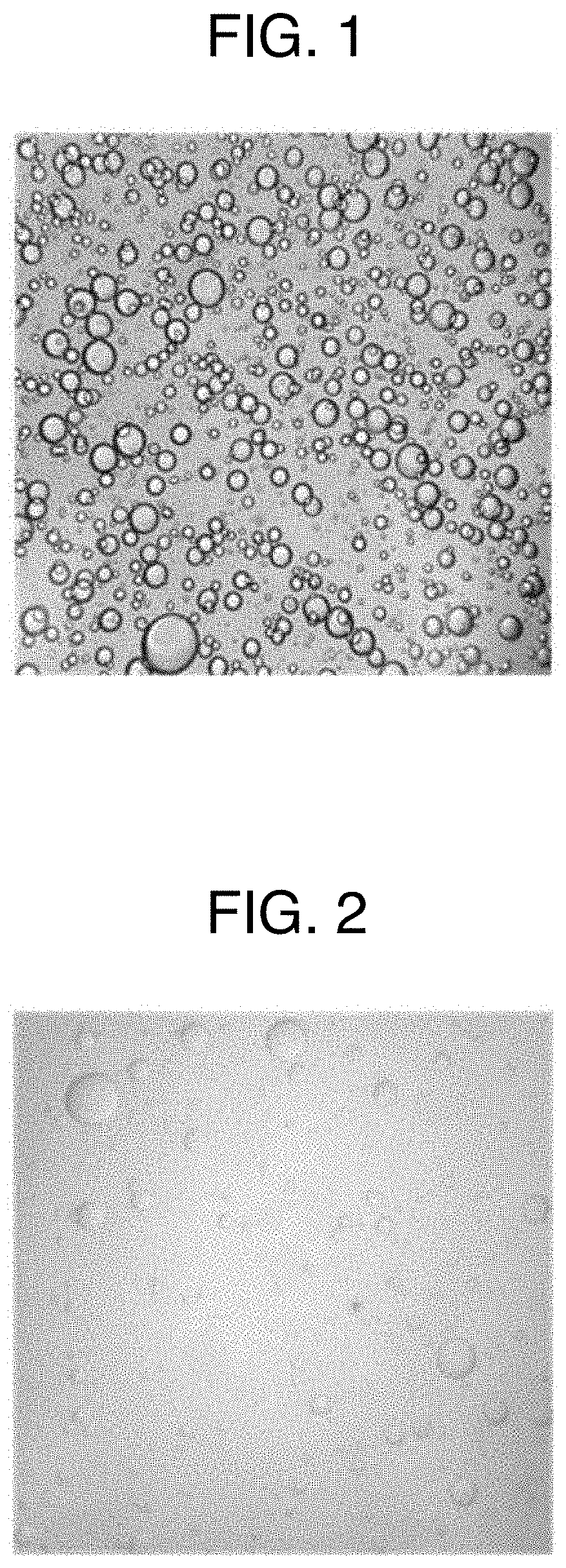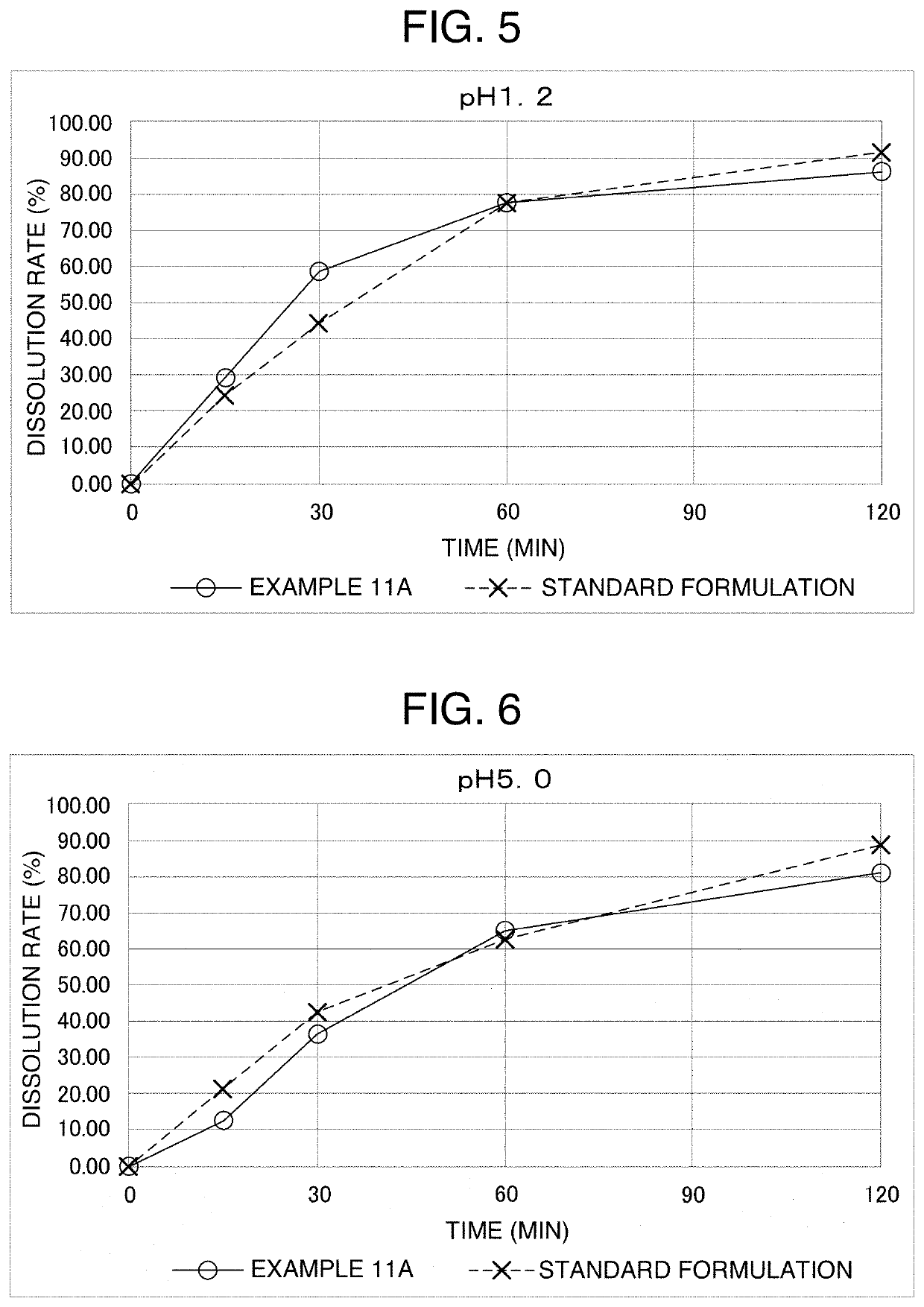Oral pharmaceutical composition and method for producing particulate formulation comprising composition
a technology of composition and composition, applied in the field of oral pharmaceutical composition, can solve the problems of poor productivity, cumbersome tasks, and high risk of severe side effects, and achieve the effects of convenient dosage adjustment, optimized dissolution properties, and high ingestibility
- Summary
- Abstract
- Description
- Claims
- Application Information
AI Technical Summary
Benefits of technology
Problems solved by technology
Method used
Image
Examples
example 1
[0074]A “gelatin aqueous solution” (water-soluble polymer aqueous solution) was obtained by adding 2.496 g of gelatin and 2.496 g of lactitol to 7.738 g of purified water, then by heating an obtained mixture at 55 to 65° C. to dissolve the gelatin and the lactitol. On the other hand, an “active ingredient solution” was obtained by adding 0.022 g of sirolimus to 2.247 g of diethyl phthalate, then heating an obtained mixture at 55 to 65° C. to dissolve the sirolimus. A “mixed liquid” (mixed aqueous solution) was obtained by adding gradually the “active ingredient solution” into the “gelatin aqueous solution” while stirring the “gelatin aqueous solution” at 55 to 65° C. In this “mixed liquid,” the droplets of diethyl phthalate where sirolimus was completely dissolved were uniformly dispersed in the “gelatin aqueous solution.”
[0075]The above “mixed liquid” was added dropwise by 25 to 40 mg at a time in 250 mL of medium chain fatty acid triglyceride which was cooled to 10 to 15° C., then...
example 2
[0076]0.011 g of xanthan gum and 0.011 g of locust bean gum were added to 8.672 g of purified water, then heated at 75 to 80° C. to dissolve the xanthan gum and the locust bean gum, and an obtained mixture was allowed to cool at room temperature for 2 h. The “gelatin aqueous solution” was obtained by adding 2.168 g of gelatin and 2.168 g of lactitol to this aqueous solution, then heating an obtained mixture at 55 to 65° C. to dissolve the gelatin and the lactitol. On the other hand, the “active ingredient solution” was obtained by adding 0.020 g of sirolimus to 1.951 g of propylene glycol monocaprylate, then heating an obtained mixture at 55 to 65° C. to dissolve the sirolimus. The “mixed liquid” was obtained by adding gradually the “active ingredient solution” into the “gelatin aqueous solution” while stirring the “gelatin aqueous solution” at 55 to 65° C. In this “mixed liquid,” the droplets of propylene glycol monocaprylate where sirolimus was completely dissolved were uniformly ...
example 3
[0078]7.67 g of a particulate formulation was obtained by preparation in the same way as in Example 1, except that in the “gelatin aqueous solution” of Example 1, 7.181 g of purified water, 2.688 g of gelatin and 3.840 g of reduced sugar syrup were used, and in the “active ingredient solution”, 0.042 g of carbamazepine and 1.250 g of diethyl phthalate were used. The loss on drying of this particulate formulation was 10.5%, the mass per particle was 21.3 mg on average (water content: about 11.2 mass %), and the particle diameter was 2.8 to 3.4 mm.
PUM
| Property | Measurement | Unit |
|---|---|---|
| particle diameter | aaaaa | aaaaa |
| partition coefficient log P | aaaaa | aaaaa |
| particle diameter | aaaaa | aaaaa |
Abstract
Description
Claims
Application Information
 Login to View More
Login to View More - R&D
- Intellectual Property
- Life Sciences
- Materials
- Tech Scout
- Unparalleled Data Quality
- Higher Quality Content
- 60% Fewer Hallucinations
Browse by: Latest US Patents, China's latest patents, Technical Efficacy Thesaurus, Application Domain, Technology Topic, Popular Technical Reports.
© 2025 PatSnap. All rights reserved.Legal|Privacy policy|Modern Slavery Act Transparency Statement|Sitemap|About US| Contact US: help@patsnap.com



